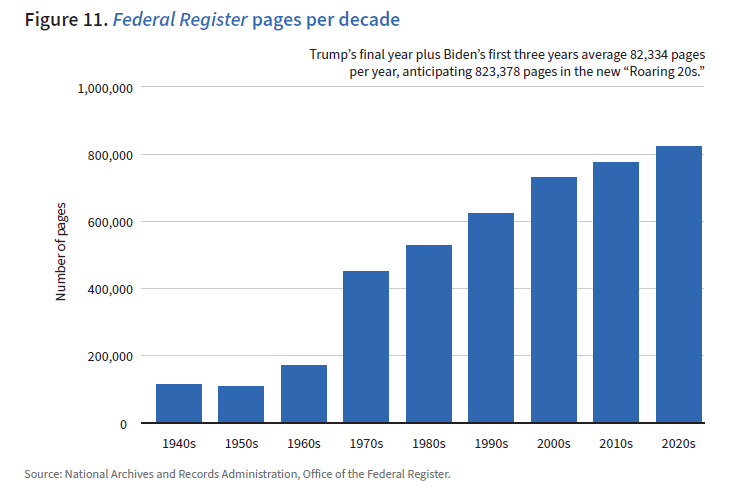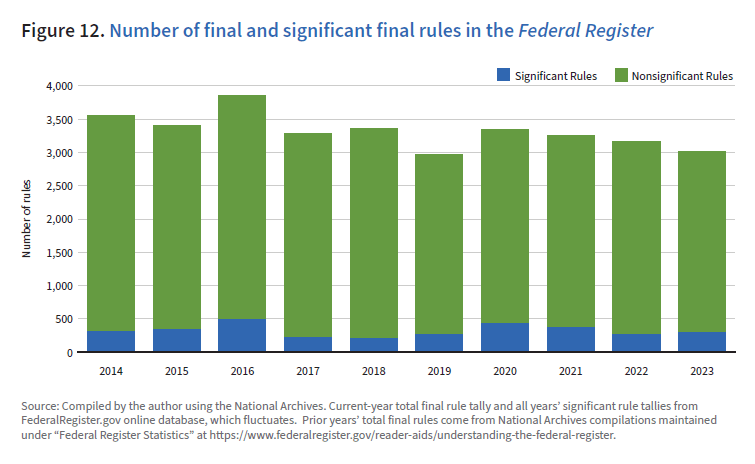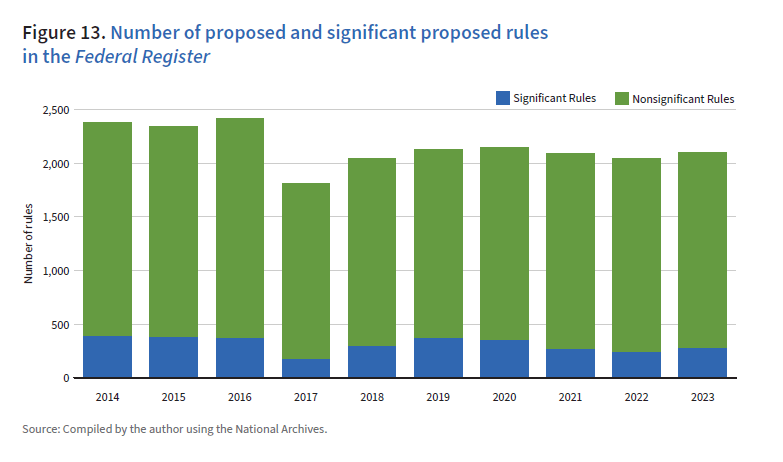Chapter 3: Page counts and numbers of rules in the Federal Register
The Federal Register is the daily repository of all proposed and final federal rules and regulations. Although its number of pages is often cited as a measure of regulation’s scope, there are obvious shortcomings with relying on page counts as a metric. A short rule may be costly, whereas a lengthy one may be relatively cheap. The Federal Register also contains many administrative notices, corrections, rules relating to the governance of federal programs and budgets, presidential statements, and other materials that contribute bulk and bear some relation to the flow of regulation, but are not strictly regulations. Blank pages, skips, and corrections also affect page counts. Shortcomings notwithstanding, it is worthwhile to track the Federal Register’s page counts.
On December 29, 2023, the Federal Register closed out at 89,368 pages, the second-highest count ever, and up 12 percent over 2022 (see Figure 8). Counts are up 25 percent over the past 5 years, 15 percent over the past 10 years.
One can compare Biden’s Federal Register tally with two extremes. At the end of 2016, Obama’s final calendar year, the number of pages peaked at 95,894. Conversely, the first calendar year of the Trump administration concluded with 61,067 pages.
The last time the annual page count had been lower than 2017 was in 1992 during the Clinton administration, at 57,003 pages. A drop in page counts between administrations is typical, as incoming presidents freeze the pipeline temporarily and launch their own priorities. Figure 8, for example, depicts a substantial drop between Trump and Biden, even though over 6,000 pages between January 1, 2021, and Biden’s inauguration on January 20 belonged to Trump.
Of the 20 all-time high Federal Register page counts, 7 occurred during the Obama administration as Table 4 shows. For the history of Federal Register page totals since 1936, see Appendix D.



Federal Register pages devoted to final rules
Isolating the pages devoted to final rules rather than gross page counts omits pages dedicated to proposed rules, agency notices, corrections, and presidential documents, although those can also have regulatory effects. Such counts tend to show a surge as presidential terms near their end and “midnight rules” are issued.
Biden’s third year concluded with 26,286 pages devoted to final rules, the fourth-highest on record and a 21 percent increase over 2022. Final-rule page bulk is up 26 percent over 5 years and 6 percent over 10 years (see Figure 9).
The extremes were 18,214 pages devoted to final rules in 2018 marking the lowest count since 1993, and the count of 38,652 in 2016, which was the highest ever (under Obama). Obviously, some rules are bulkier than others and affect tallies like these. Trump’s streamlining-oriented Safer Affordable Fuel-Efficient (SAFE) Vehicles Rule for model years 2021–2026, for example, clocked in at 1,105 pages.
Alongside these final-rule pages, the pages of proposed rules in the regulatory pipeline are noteworthy given their implications for future regulatory costs and their potential as a leading indicator heralding growth or decline in the number of future final rules. Federal Register pages devoted to proposed rules surged 21 percent between 2022 and 2023 to an all-time high of 28,892 (see Figure 10), even though, as we’ll see, Biden’s number of proposed rules is relatively low. Before Biden, the number of pages devoted to proposed rules had peaked at 23,193 in 2011 under Obama. The 10,495 in 2017 under Trump was the lowest seen since 1977.
Federal Register pages published by decade
Federal Register pages per decade provide one more way to characterize the Federal Register and longer-term trends (see Figure 11), hinting that a million pages per decade may become normal.



During the 2010s, 775,734 pages were added to the Federal Register, for an average of 77,573 pages each year. Four years into the 2020s, which includes Trump’s final calendar year and Biden’s first three, the average is 82,334 annually. Figure 11’s extrapolation for the remainder of the 2020s shows an expected inventory of 823,378 pages, approaching twice the level of the 1970s when overregulation was a concern and liberalization in transportation and financial services occurred.
Number of final (and significant final) rules in the Federal Register
For the year 2023, Biden can freely claim that he has the lowest final rule count of any president apart from Trump, but that is not the same as being less of a regulator than predecessors. A trend toward fewer but costlier larger rules may be underway, perhaps supplemented by guidance documents and subregulatory decrees that can substitute for formal rulemaking as federal consolidation expands, as described in the previous two editions of this report. Biden sports an affinity for antitrust, trade and tech interventions, family leave policies, and other pursuits that may not appear as rules in the Federal Register at all and that are not readily tracked in OMB rule reviews.
The 89,368-page Federal Register contained 3,018 final rules in 2023, the lowest count on record apart from Trump’s 2,964 in 2019 (see Figure 12), which had been the only count below 3,000 since recordkeeping began in the 1970s. In 2016, the final full year of the Obama administration, the number of final rules reached 3,853, the highest count since 2005. The average for the 2000–2009 period was 3,945. Rule counts were routinely higher in the past: before 2005, rule counts exceeded 4,000 for all years. The annual average in the 1990s was 4,596, and even higher in the decades prior. Final rule counts now stand well below these levels. The seeming paradox of fewer rules but a fatter Federal Register may in part be explained by rules getting longer or more detailed, proposed rules in particular, as may be observed in Appendix E.
The subset of the total final rules deemed significant under Executive Order 12,866 is also presented in Figure 12. Biden had 289 significant final rules in 2023, down from his 375 in 2021. Biden’s acknowledged significant rules exceed those of Trump; however, they have not fully resumed heights seen under Barack Obama, when significant rules topped 400 three times, including the peak of 486 in 2016. (See Appendix E for earlier years.)
Recognizing that overlap occurs in transition years, here are calendar-year breakdowns of final and significant final rules published in the Federal Register during recent administrations:
- Barack Obama (eight years): 3,037 significant rules, average 380 per year
- Donald Trump (four years): 1,121 significant rules, average 280 per year (some deregulatory)
- Joe Biden (first three years): 932 significant rules, average 311 per year
Box 1 in a later section will inventory the costliest tier of these significant rules for 2023.
Cumulative final rules in the Federal Register
The annual outflow of over 3,000 final rules (except for Trump’s 2,964 rules in 2019) has resulted in 120,475 total new rules since 1993, when the first edition of Ten Thousand Commandments was published, through the end of 2023. Since 1976, when the Federal Register first began itemizing rules, 217,565 final rules have been issued. Since 1996, the year the Congressional Review Act (CRA) was passed, 101,589 rules have been issued, but fewer than two dozen CRA resolutions of disapproval have succeeded. (See again Appendix E.)
Number of proposed (and significant proposed) rules in the Federal Register
Proposed rules in the pipeline also sit at historic lows, as Biden’s overall proposed rule counts are not yet above pre-Trump levels. The year 2023 concluded with 2,102 proposed rules in the Federal Register, of which 277 were deemed significant (see Figure 13). Trump’s first year tally of 1,809 is notable as an all-time low, despite including over 150 issued by Obama during the first weeks of 2017. As observable in Appendix E, the average in the 1990s was 3,164 per year. The average from 2000 to 2010 was 2,662 annually.

